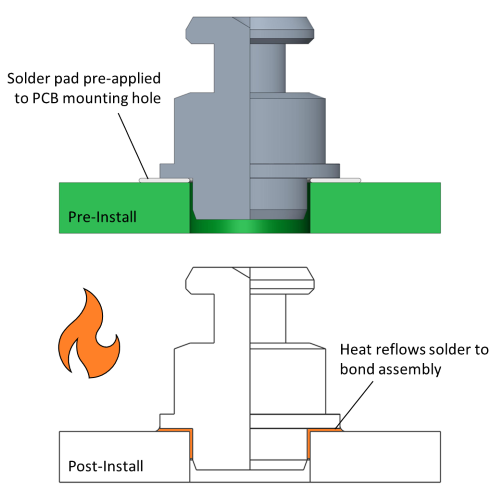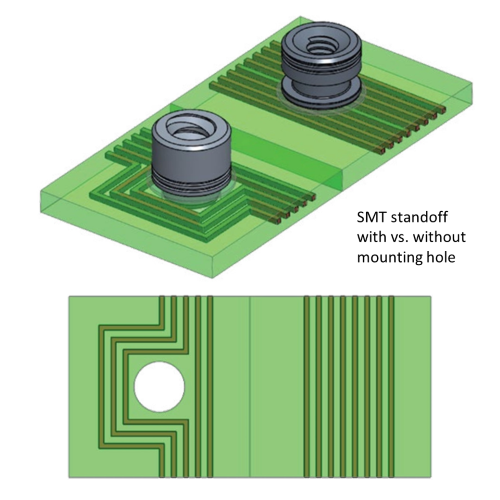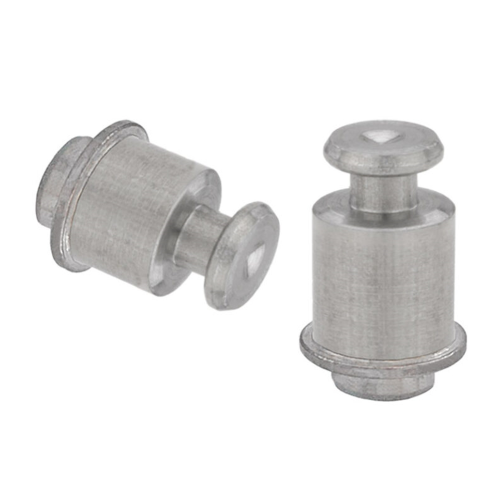Surface Mounting Technology (SMT)
Table of Contents
Product Pages
Standoffs
KEYHOLE® Standoffs
SNAP-TOP® Standoffs
Nuts
Clinch Nuts
Floating Nuts
Blind Nuts
Flush Nuts
Locking Nuts
Rivet Nuts
Studs
Locating Pins
Captivated Screws
Simple Screws
Spring-Loaded Screws
Knob Cap Screws
Threaded Inserts
Press-In Inserts
Molded-In Inserts
Ultrasonic/Heat-Staking Inserts
Compression Limiters
Specialty Fasteners
Cable Tie Mounts
TACKPIN®
Panel-to-Panel Fasteners
Right Angle Fasteners
Attachment Technologies
How It Works
Electrical components that host a system of wires and connections on sensors and circuit boards use soldering to ensure a conductive path quickly and reliably. Solder paste is a substance that can be painted onto contact pads and wires at room temperature and is heated to cause reflow. This is where the paste turns into a molten tin-lead alloy that creates a permanent electrical connection.
Fasteners that use surface mounting technology (SMT) leverage reflow soldering to attach to PCBs, depending on the surface area of the solidified solder to provide pull-out and torque resistance. While most SMT fasteners are designed with a shank for a pilot hole, new options for pilotless SMT are now available. They allow fasteners like standoffs to be placed anywhere on a PCB’s surface prior to reflow, further streamlining the production process for OEMs.

Advantages & Limitations
SMT fasteners provide cost savings over through-hole solutions with simpler features and streamlined installation – removing the need for displacement and interference features like knurls or burrs. No install force is required since parts can be machine placed at room temperature with solder paste that can be reflowed with the rest of the electrical connections on the PCB, shortening assembly time. Pilotless standoffs can be mounted directly on top of copper traces that would otherwise have to travel around a through-hole, resulting in the potential for more dense electrical components.

Damage caused to PCB due to oversized install of broaching nut close to edge.

Pilotless surface mount standoffs can be mounted directly on top of embedded copper traces.

Easily visible SMT defect known as "tombstoning," caused by asymmetric solder or reflow.
Like any of the soldered components on a PCB, the biggest challenges associated with SMT fasteners involve inspection and reparability limitations. The bonding interfaces between the fastener, solder, and circuit board are difficult to visually inspect for defects. This can cause issues in the production process or final product. Additionally, since SMT fasters are soldered directly onto a circuit board, mechanical failure could result in damage to the electrical components. This can render a product defunct or require replacement parts. However, alternative attachment methods like broaching require far more space to securely adhere to a PCB and involve higher installation forces, which can also cause damage in production.
Common Applications
SMT fasteners are almost strictly limited to electrical components, as it involves PCB mounting by soldering directly to a circuit board. This means that any product or industry that involves electronics could benefit from using the reflow capabilities of SMT fasteners, most popularly surface mount standoffs, to streamline their production.
Relevant products from PEM:
Explore surface-mounted PEM solutions in our Product Finder:
Visit the K Datasheet to learn more about our surface mount nuts and standoffs for PCBs.
Have a project?
Let’s get started.
Talk to us about creating a custom part, tool or process. We are equipped to help you to take on and solve your biggest engineering challenges.
Talk to us about creating a custom part, tool or process. We are equipped to help you to take on and solve your biggest engineering challenges.

Looking for CAD Downloads?
Access to the original PEM Catalog and CAD downloads.
Have a question?
Talk to an Engineer.
See what’s possible.
Connect with a PEM® engineering expert today and discover a reliable, cost-effective fastening solution for your challenging applications.
Or Call Us: 1-800-342-5736








